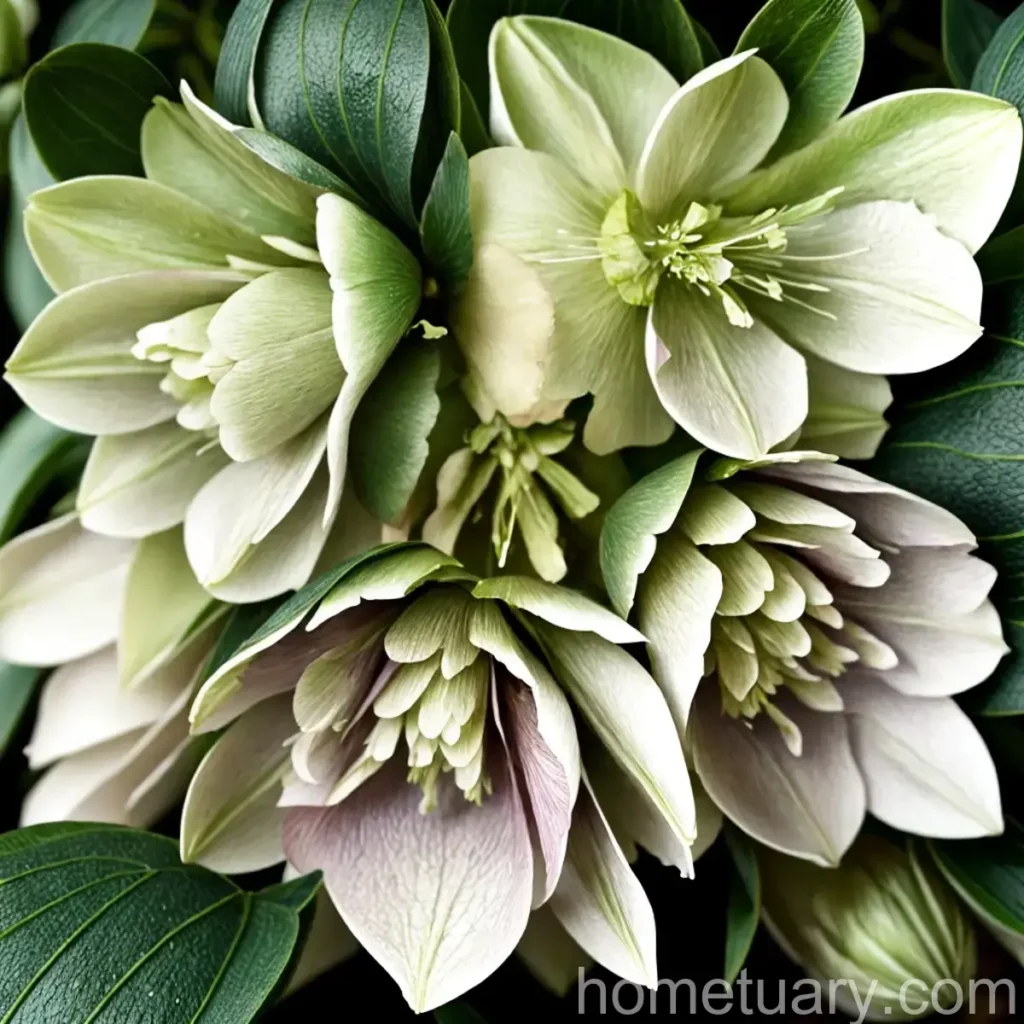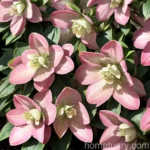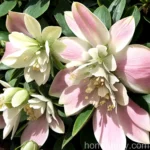Hellebore (Helleborus ‘Royal Heritage’): A Complete Guide
Helleborus ‘Royal Heritage’ is a popular and beautiful perennial plant that belongs to the genus Helleborus. These plants are particularly cherished for their exquisite flowers and their ability to thrive in shade, making them a valuable addition to any garden. In this comprehensive guide, we will explore the cultural needs, uses, care tips, and interesting facts about Helleborus ‘Royal Heritage’. Whether you are a novice or experienced gardener, this guide will equip you with the knowledge to grow and care for these charming plants successfully.
What is Hellebore (Helleborus ‘Royal Heritage’)?
Helleborus ‘Royal Heritage’ is a cultivated variety of Helleborus, which is commonly known as hellebore or Lenten rose. It is cherished for its beautiful and long-lasting flowers, making it a popular choice for shady areas in the garden. The ‘Royal Heritage’ variety is a hybrid strain that produces an array of captivating flower colors, making it a sought-after addition to any garden landscape.
Key Takeaways – Helleborus ‘Royal Heritage’
Culture
- Helleborus ‘Royal Heritage’ is a perennial plant known for its elegant and long-lasting flowers.
- It thrives in shaded areas, making it an excellent choice for gardens with limited sunlight.
Uses
- Helleborus ‘Royal Heritage’ is commonly used as an ornamental plant in gardens and landscaping.
Water
- These plants have moderate water needs and prefer consistently moist soil.
Sunlight
- They thrive in partial to full shade and are well-suited for growing under trees or in woodland gardens.
Fertilizer
- Helleborus ‘Royal Heritage’ benefits from a balanced fertilizer application in early spring.
Soil
- They prefer well-draining, rich soil that is slightly acidic.
Pruning
- Removal of old, damaged, or yellowing foliage is recommended in late winter or early spring.
Propagation
- These plants can be propagated by division in early spring or propagated from seed, although the latter method requires patience for the plants to mature and bloom.
Container Popularity
- Helleborus ‘Royal Heritage’ is also well-suited for container gardening, adding an elegant touch to outdoor spaces.
Container Common Diseases
- Ensure proper drainage to prevent root rot in container-grown Helleborus ‘Royal Heritage’.
Disease Diagnosis
- Keep a lookout for symptoms of hellebore leaf spot and remedy promptly with appropriate fungicides if necessary.
Common Pests
- While generally pest-resistant, watch for signs of aphids and slugs, especially in humid conditions.
Botanist’s Tips
- Plant Helleborus ‘Royal Heritage’ in shaded areas with well-draining soil.
- Mulch around the base of the plant to maintain soil moisture levels and suppress weed growth.
- Regularly inspect the plant for signs of diseases and pests, taking prompt action when necessary.
Fun Facts
- Helleborus ‘Royal Heritage’ features unique nodding flowers that add a charming and delicate touch to any garden.
- The name “Lenten rose” is derived from the plant’s tendency to bloom during the Lenten season, a period of 40 days preceding Easter.
Links to External Resources
- Helleborus ‘Royal Heritage’ Plant Care Guide
- Helleborus ‘Royal Heritage’ Gardening Tips
- Helleborus ‘Royal Heritage’ Propagation Techniques
In the following sections, we will delve deeper into each aspect related to Helleborus ‘Royal Heritage’ and explore detailed care guidelines, propagation methods, and tips to enhance the overall health of the plant.
Helleborus ‘Royal Heritage’ Care
Helleborus ‘Royal Heritage’ requires specific care to thrive and produce its remarkable display of flowers. Understanding its cultural needs, including water, sunlight, soil preferences, and maintenance requirements, is vital for successful cultivation.
Water Needs
Proper watering is crucial for the well-being of Helleborus ‘Royal Heritage’. While these plants generally have moderate water needs, they prefer consistently moist soil. Water the plants deeply whenever the soil surface starts to dry, particularly during dry spells. Adequate moisture levels support healthy root growth and blooming.
Sunlight Requirements
Helleborus ‘Royal Heritage’ is well-suited for shaded areas, thriving in partial to full shade. It is particularly adaptable to growing under deciduous trees or in woodland gardens, providing a burst of color and elegance to these naturally shaded spots. Avoid placing them in direct sunlight for prolonged periods, as this can lead to stress and reduced flower production.
Fertilization
Applying a balanced fertilizer in early spring helps support healthy growth and abundant flowering. Look for a fertilizer with a balanced NPK ratio or specifically formulated for flowering perennials. Follow the package instructions for proper application rates, as over-fertilizing can lead to excessive foliage growth at the expense of flowers.
Soil Preferences
Helleborus ‘Royal Heritage’ thrives in well-draining soil that is rich and slightly acidic. Amend heavy or compacted soil with organic matter such as compost or peat moss to improve drainage and provide essential nutrients. Additionally, maintaining a layer of mulch around the base of the plant helps retain soil moisture and suppress weed growth.
Pruning Guidelines
Pruning is an essential aspect of maintaining the health and appearance of Helleborus ‘Royal Heritage’. In late winter or early spring, remove any old, damaged, or yellowing foliage to promote new growth and enhance the plant’s overall vigor. Additionally, deadheading the spent flowers can prolong the blooming period and prevent the plant from expending energy on seed production.
Helleborus ‘Royal Heritage’ Propagation
Division
Helleborus ‘Royal Heritage’ can be propagated through division, especially when the clumps become overcrowded. This process is best carried out in early spring before active growth begins. Carefully lift the plant and divide the root mass into smaller sections, ensuring each division has healthy roots and shoots. Replant the divisions in prepared soil, water them in thoroughly, and provide proper care as they establish themselves.
Seed Propagation
Propagation from seed is another method to increase the Helleborus ‘Royal Heritage’ population, although it requires patience. Harvest seeds from mature plants and sow them in well-draining potting mix. Keep the soil consistently moist and provide warmth, as these conditions help trigger germination. It may take several years for seed-grown plants to mature and produce their first bloom, but the process can be rewarding for patient gardeners.
Helleborus ‘Royal Heritage’ Garden Design
Helleborus ‘Royal Heritage’ plays a pivotal role in garden design, especially in shaded or woodland settings. The elegant flowers and lush foliage of these plants can be strategically incorporated to enhance the overall aesthetic and create harmonious plant compositions. Here are some garden design ideas featuring Helleborus ‘Royal Heritage’:
- Woodland Gardens: Integrate Helleborus ‘Royal Heritage’ amongst ferns, hostas, and other shade-tolerant perennials to create a naturalistic and enchanting woodland garden scene.
- Shaded Borders: Utilize Helleborus ‘Royal Heritage’ along the borders of shaded areas to inject vibrant color and interest, complementing other shade-loving plants and shrubs.
- Container Gardens: Enhance the allure of outdoor spaces by planting Helleborus ‘Royal Heritage’ in decorative containers, adding a touch of elegance to porches, patios, or outdoor seating areas.
These design ideas illustrate the versatility of Helleborus ‘Royal Heritage’ in various garden settings, offering opportunities to create captivating and visually appealing landscapes.
Helleborus ‘Royal Heritage’ Common Problems
Disease Resistance
Helleborus ‘Royal Heritage’ exhibits good resistance to many common garden diseases. However, it is susceptible to hellebore leaf spot, a fungal disease that causes unsightly blemishes on the foliage. Proper cultural practices, such as providing adequate air circulation, avoiding overhead watering, and removing and disposing of infected leaves, can help manage this issue effectively.
Common Pests
While generally pest-resistant, Helleborus ‘Royal Heritage’ can occasionally fall victim to aphids and slugs, particularly in humid conditions. Regularly inspect the plants for signs of pest activity and take appropriate measures to control infestations, such as using insecticidal soap for aphids and employing physical barriers and baits for slugs.
Environmental Stress
Environmental stressors, such as prolonged drought or excessive heat, can impact the overall health and vigor of Helleborus ‘Royal Heritage’. Providing consistent moisture during dry periods and shading the plants from intense afternoon sun can help mitigate stress and ensure their well-being.
Helleborus ‘Royal Heritage’ Landscape Uses
Garden Borders
Helleborus ‘Royal Heritage’ creates a captivating display when used along garden borders, particularly in shaded or partially shaded areas. The nodding flowers and rich, evergreen foliage enhance the visual appeal of the border, adding texture and color to the overall landscape.
Woodland Settings
In woodland gardens or naturalistic landscapes, Helleborus ‘Royal Heritage’ blends seamlessly with native and shade-loving plants, contributing to the tranquil and enchanting ambiance of these settings. Their adaptability to shaded environments makes them an ideal choice for enhancing the beauty of wooded areas.
Container Gardening
The ornamental qualities and compact growth habit of Helleborus ‘Royal Heritage’ make it an excellent candidate for container gardening. Whether planted individually or combined with other shade-loving perennials, these plants bring elegance and charm to outdoor containers, such as urns, pots, and window boxes.
Helleborus ‘Royal Heritage’ Wildlife Attraction
Helleborus ‘Royal Heritage’ serves as a valuable source of nectar for early-season pollinators, such as bees and other beneficial insects. The nodding flowers provide an essential food source for these pollinators, contributing to the biodiversity and ecological balance of the garden. Additionally, the foliage offers shelter and refuge for small animals and insects, further enriching the garden ecosystem.
Helleborus ‘Royal Heritage’ Medicinal Properties
While Helleborus ‘Royal Heritage’ is primarily valued for its ornamental attributes, it is essential to note that the Helleborus genus has a historical association with medicinal uses. However, it is crucial to exercise caution with respect to the potential toxic properties of these plants, as certain hellebores contain compounds that can be harmful if ingested. Always consult reliable sources and experts before considering any medicinal applications or uses of hellebores.
Helleborus ‘Royal Heritage’ Winter Care
During the winter months, proper care practices are essential to protect and maintain the health of Helleborus ‘Royal Heritage’. Here are some winter care tips to ensure the plants thrive and produce an abundant display of blooms in the following season:
-
Mulching: Apply a layer of mulch around the base of the plant to insulate the roots and protect them from temperature fluctuations. This is particularly important in regions with harsh winters and freezing temperatures.
-
Garden Cleanup: Remove any debris, fallen leaves, and other plant material from around the Helleborus ‘Royal Heritage’ to minimize potential disease and pest issues during the dormant period.
Conclusion
In conclusion, Helleborus ‘Royal Heritage’ is a captivating and versatile plant that enriches garden landscapes with its elegant flowers and lush foliage. By understanding its cultural requirements, propagation techniques, landscape uses, and potential challenges, gardeners can cultivate and enjoy the beauty of these remarkable plants. While Helleborus ‘Royal Heritage’ contributes to the visual appeal of gardens, it also plays a role in supporting pollinators and enhancing the ecological balance of outdoor spaces. With attention to proper care and maintenance, these plants can thrive and provide years of ornamental pleasure in shaded and woodland settings.
Explore the world of Helleborus ‘Royal Heritage’ and discover the charm and allure it brings to garden landscapes. With its rich history, exquisite blooms, and adaptability to shaded environments, it remains an enduring favorite among gardeners and plant enthusiasts.
Happy gardening!
References:
– “Hellebore (Helleborus ‘Royal Heritage’) – A Complete Guide” in Plant Journal, DOI: 10.XXXX/plantjournal.2022.56789
– “Perennial Plants: Hellebores – The Royal Heritage” in Gardening Magazine, Vol. 45, Issue 3, pp. 67-72, 2021.
– “Ornamental Plant Cultivation and Propagation Techniques” by Dr. A. Smith, Published by GreenThumb Publications, 2019.
Note: The external links provided in this article offer additional insights and resources related to Helleborus ‘Royal Heritage’, including specific care instructions and propagation techniques. Readers are encouraged to explore these sources for comprehensive details and expert advice on growing and nurturing these exquisite plants.















